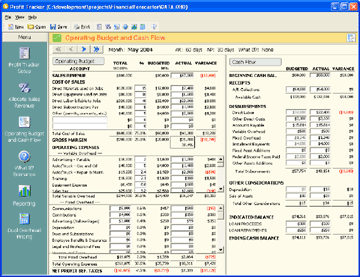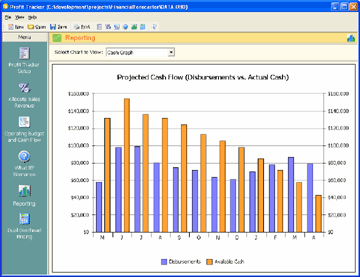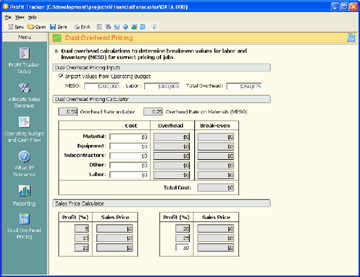ProfitTracker
leads the industry in providing measurement tools for business success.
With ProfitTracker software, any contractor can easily produce budgets,
make cash flow projections, calculate labor pricing strategies for jobs
and determine breakeven points based on their own financial information.
Budgeting, sometimes
that word brings up a picture in your head of being bleary eyed, making
complex calculations long into
the night, fighting a pounding headache and drinking cups of strong
coffee to make it through the process. But it doesn’t have to be that
way. With
ProfitTracker software you can simplify this process without getting
the slightest headache. Using expenses from last year, you can easily create a monthly budget.
This can be a simple budget using totals or you can make it as detailed
as you want by breaking down all cost. All you have to do is plug in
as few as number or as many numbers as you desire and print a monthly
budget. This software does all the calculations for you, so no bleary
eyes.
Each year you can save the previous budgets, making it easier to
create a new one and forecast upcoming capital expenses and
needed monthly sales.
Budgets:
-
Calculated from past
years’ data
-
Based on Return-on-Investment
-
Create monthly or annual
-
Breakdown all costs
-
Definitive variable
and fixed OH
-
Net profit per month
-
Create/modify direct
costs
-
Project sales per month
-
Print annual/monthly
budgets
-
Save budgets year to
year, mo to mo

Operating Budget and Cash
Flow
Cash
flow is essential to the life of any contracting company. It’s that little
item that takes the bumps out of the road,
sooths the ulcer and makes you smile. Well, it does all that if is positive
cash flow! With ProfitTracker software you will no longer have to guess
about how much you need to sell to pay your bills or guess what to charge
for jobs. Using Aging of A/R & A/P and considering installment payments
you can make cash flow projections and see exactly how much cash you
have and if it is enough to pay your expected costs.
Cash Flow:
-
Based on aging of A/R
and A/P
-
Considers installment
payments
-
Gives ending cash balances/mo
-
Inject new costs into
system
-
Allows income tax entries
-
Change aging parameters
or cash
-
Graph cash outflow/inflow
-
Bar charts available
to match months

Reporting Screen
Dual
Overhead, the most accurate method for calculating
overhead allocation of material, equipment, labor. Using this, a contractor
can figure any replacement job quickly and easily. ProfitTracker calculates
breakeven for you and then allows you to determine the percent profit
you desire.
Dual OH:
-
Calculate breakeven
for labor
-
Calculate breakeven
for MESO
-
Determine correct selling
prices
-
Change parameters for
breakeven
-
Automatically calculated
from budget
-
Change to meet needs

Dual
Overhead Pricing Screen
Scenarios, dream up as many as you want because ProfitTracker
can provide just about any “what if” scenario you can think up. You may
change any one or more parameters and see how cash flow changes, budgets
revise and profit changes. What a great way to manage growth!
What If’s:
-
Change sales volume
projections
-
Change direct costs
outlays
-
Change price parameters
-
Change variable overhead
-
Change fixed overhead
-
Change cash outputs/inputs
-
Print what if’s to
budget
-
See how cash flow changes
-
Manipulate profit

or reach us by email: info99@collier-consulting.com
What can PT really do for my business?
Most businesses do not have a
business plan that consists of a budget and cash flow projection for
the company. PT will create annual and monthly budgets and projections.
In addition PT can help you price jobs.
Why do a cash flow projection?
Most businesses fail because they cannot pay their bills. They do not
fail from a lack of sales or customers. It is imperative for a business
to function that they can pay their bills each and every month.
What is Return on Investment?
Budgets should be created from the profit viewpoint, not from sales.
Return on Investment (ROI) focuses on how much money the company wants
to make on its assets. The earned monies is called profit.
What is common ROI for the contracting business?
Common ROI for the HVAC and Plumbing industry is 14%. However, you should
always budget at least 35%.
Where do I get my values needed to start ProfitTracker?
You really need your last year's profit and loss, last year's balance
sheet, and monthly sales values for the last 12 months.
Can
PT help me determine my breakeven for inventory and labor sales?
Yes, PT uses the dual overhead formula to calculate the overhead burden for
both inventory that you sell and labor (like service or install) that you sell.
Breakeven is the cost of an item that you sell plus the overhead (handling
charge) that the company needs to make a profit of $0. Add profit to breakeven,
and you have a selling price.
What's
the difference in profitability and cash flow?
Profitability is shown on the income or profit/loss statement and the difference
between sales and costs. Profitability is the result of sales activities revealing
if you made or lost profit. Profitability exists on paper and not necessarily
at the bank. One might show a profit of $1000 one day, but the monies may not
be in the bank that day. Cash flow is the actual monies being deposited and
withdrawn at the bank on a daily, weekly, or monthly basis. It is the money
you have to spend for the costs of sales, loan payments, etc.
What
cost items go in "Costs of Goods Sold"?
Look at the category name, "Costs of Goods Sold". It is not "Cost
of Goods Bought". These are items I purchased and have sold to someone.
Typically, these items can be broken down into five (5) categories: Costs of
Material Inventory Sold; Cost of Equipment Inventory Sold; Miscellaneous Costs
such as specific insurance for jobs, permits, etc.; Cost of Subcontract Labor,
and Cost of Field Employee Labor. Also, all costs in this category can be traced
directly to specific jobs or job costed to specific jobs.
What
is overhead?
Overhead is the sales expenses that are generic in nature. Expenses that are
used to support the costs of goods sold are typically broken into "fixed" and "variable".
Overhead expenses are difficult to tie directly to any specific sale or job.
For example, the office person's salary cannot easily be divided among departments
or jobs.
Where
do owners' salaries go?
Depending on the business structure, corporate salaries go into Fixed Overhead.
If you are a sole proprietor, you take a draw. Draws are shown on the profit/loss
after the line of Profit.
Which
is better, Sole Proprietor or Corporation?
Corporations are the better business structure. As a corporation, you as an
owner work for the company as an employee and are entitled to all benefits
offered to employees. Also, if a lawsuit occurs against the corporation, you
probably are not held liable because you are an employee like everyone else. |


![]()